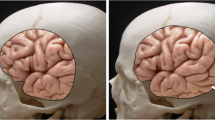Abstract
Approximately 30 % of patients with moyamoya disease (MMD) have presented with involvement of the posterior circulation, mainly the posterior cerebral artery (PCA). Diagnosis of delayed progression of PCA stenosis in MMD may be difficult due to the diversity in clinical features. The goal of this study was to evaluate pediatric MMD patients with delayed PCA involvement after completion of revascularization of the anterior circulation. Forty-one pediatric MMD patients who underwent revascularization of the PCA territory due to delayed posterior circulation insufficiency MMD from 2006 to 2011 were retrospectively reviewed. The average interval between the initial operation and the occipital artery (OA) procedure was 5.0 years. Common symptoms were headaches and transient visual symptoms. The decision to operate was made based on a combination of diagnostic tools. The results obtained with perfusion MRI, SPECT, MR angiography, and EEG supported posterior circulation insufficiency in 78, 41, 73, and 71 % of patients, respectively. Encephaloduroarteriosynangiosis (EDAS) using the OA was performed in 15 patients, and 26 patients received multiple burr hole trephination of the occipital area. All patients showed clinical improvement. Clinicians should be aware of the possibility of delayed involvement of the PCA in pediatric MMD patients. The clinical decision regarding treatment should be based on a combination of symptomatology and the results obtained with various tools to assess whether the blood flow in the PCA territory is insufficient. Surgical treatment using indirect revascularization appears to be effective for patients with delayed PCA involvement.


Similar content being viewed by others
References
Cho A, Chae JH, Kim HM, Lim BC, Hwang H, Hwang YS, Phi JH, Kim SK, Wang KC, Cho BK, Kim KJ (2014) Electroencephalography in pediatric moyamoya disease: reappraisal of clinical value. Childs Nerv Syst 30:449–459
Choi IJ, Hong SH, Cho BK, Wang KC, Kim SK (2005) Encephalo-duro-arterio-synangiosis (EDAS) using occipital artery in children with moyamoya disease. J Korean Neurosurg Soc 38:413–418
Endo M, Kawano N, Miyaska Y, Yada K (1989) Cranial burr hole for revascularization in moyamoya disease. J Neurosurg 71:180–185
Fukui M (1997) Guidelines for the diagnosis and treatment of spontaneous occlusion of the circle of Willis (‘moyamoya’ disease). Research Committee on Spontaneous Occlusion of the Circle of Willis (Moyamoya Disease) of the Ministry of Health and Welfare, Japan. Clin Neurol Neurosurg 99(Suppl 2):S238–S240
Huang AP, Liu HM, Lai DM, Yang CC, Tsai YH, Wang KC, Yang SH, Kuo MF, Tu YK (2009) Clinical significance of posterior circulation changes after revascularization in patients with moyamoya disease. Cerebrovasc Dis 28:247–257
Imaizumi T, Hayashi K, Saito K, Osawa M, Fukuyama Y (1998) Long-term outcomes of pediatric moyamoya disease monitored to adulthood. Pediatr Neurol 18:321–325
Kawaguchi T, Fujita S, Hosoda K, Shose Y, Hamano S, Iwakura M, Tamaki N (1996) Multiple burr-hole operation for adult moyamoya disease. J Neurosurg 84:468–476
Kim SK, Cho BK, Phi JH, Lee JY, Chae JH, Kim KJ, Hwang YS, Kim IO, Lee DS, Lee J, Wang KC (2010) Pediatric moyamoya disease: an analysis of 410 consecutive cases. Ann Neurol 68:92–101
Kim SK, Wang KC, Kim IO, Lee DS, Cho BK (2002) Combined encephaloduroarteriosynangiosis and bifrontal encephalogaleo (periosteal) synangiosis in pediatric moyamoya disease. Neurosurgery 50:88–96
Kuroda S, Ishikawa T, Houkin K, Nanba R, Hokari M, Iwasaki Y (2005) Incidence and clinical features of disease progression in adult moyamoya disease. Stroke 36:2148–2153
Lee JY, Kim SK, Cheon JE, Choi JW, Phi JH, Kim IO, Cho BK, Wang KC (2013) Posterior cerebral artery involvement in moyamoya disease: initial infarction and angle between PCA and basilar artery. Childs Nerv Syst 29(12):2236–2239
Miyamoto S, Kikuchi H, Karasawa J, Nagata I, Ikota T, Takeuchi S (1984) Study of the posterior circulation in moyamoya disease. Clinical and neuroradiological evaluation. J Neurosurg 61:1032–1037
Moen M, Levine SR, Newman DS, Dull-Baird A, Brown GG, Welch KM (1988) Bilateral posterior cerebral artery strokes in a young migraine sufferer. Stroke 19:525–528
Mugikura S, Higano S, Shirane R, Fujimura M, Shimanuki Y, Takahashi S (2011) Posterior circulation and high prevalence of ischemic stroke among young pediatric patients with moyamoya disease: evidence of angiography-based differences by age at diagnosis. Am J Neuroradiol 32:192–198
Mugikura S, Takahashi S, Higano S, Shirane R, Sakurai Y, Yamada S (2002) Predominant involvement of ipsilateral anterior and posterior circulations in moyamoya disease. Stroke 33:1497–1500
Okada Y, Kawamata T, Kawashima A, Yamaguchi K, Ono Y, Hori T (2012) The efficacy of superficial temporal artery-middle cerebral artery anastomosis in patients with moyamoya disease complaining of severe headache. J Neurosurg 116:672–679
Seol HJ, Wang KC, Kim SK, Hwang YS, Kim KJ, Cho BK (2005) Headache in pediatric moyamoya disease: review of 204 consecutive cases. J Neurosurg 103:439–442
Suzuki J, Takaku A (1969) Cerebrovascular “moyamoya” disease. Disease showing abnormal net-like vessels in base of brain. Arch Neurol 20:288–299
Yamada I, Himeno Y, Suzuki S, Matsushima Y (1995) Posterior circulation in moyamoya disease: angiographic study. Radiology 197:239–246
Zach V, Bezov D, Lipton RB, Ashina S (2010) Headache associated with moyamoya disease: a case story and literature review. J Headache Pain 11:79–82
Acknowledgments
This study was supported by a grant of the Korea Healthcare Technology R&D Project, Ministry for Health, Welfare & Family Affairs, Republic of Korea (A120099).
Conflicts of interest
The authors declare that they have no conflict of interest.
Ethical standard
This study was conducted in accordance with the ethical standards of 1964 Declaration of Helsinki and its later amendments.
Author information
Authors and Affiliations
Corresponding authors
Rights and permissions
About this article
Cite this article
Lee, J.Y., Choi, YH., Cheon, JE. et al. Delayed posterior circulation insufficiency in pediatric moyamoya disease. J Neurol 261, 2305–2313 (2014). https://doi.org/10.1007/s00415-014-7484-7
Received:
Revised:
Accepted:
Published:
Issue Date:
DOI: https://doi.org/10.1007/s00415-014-7484-7




